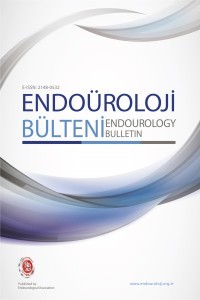Kadınlarda Visseral Adipozite İndeksi İle Aşırı Aktif Mesane Semptomları Arasındaki İlişkinin Değerlendirilmesi
aşırı aktif mesane, ürodinami, visseral adipozite indeksi
Evaluation of relationship between visceral adiposity ındex and overactivate bladder symptoms in females
overactive bladder, urodynamics, visceral adiposity index,
___
- 1. Haylen BT, de Ridder D, Freeman RM et al. (2010) An International Urogynecological Association (IUGA)/International Continence Society (ICS) joint report on the terminology for female pelvic floor dysfunction. Neurourol Urodyn 29 (1):4-20. doi:10.1002/nau.20798
- 2. Irwin DE, Kopp ZS, Agatep B, Milsom I, Abrams P (2011) Worldwide prevalence estimates of lower urinary tract symptoms, overactive bladder, urinary incontinence and bladder outlet obstruction. BJU Int 108 (7):1132-1138. doi:10.1111/j.1464-410X.2010.09993.x
- 3. Kim SY, Bang W, Choi HG (2017) Analysis of the prevalence of and factors associated with overactive bladder in adult Korean women. PLoS One 12 (9):e0185592. doi:10.1371/journal.pone.0185592
- 4. Link CL, Steers WD, Kusek JW, McKinlay JB (2011) The association of adiposity and overactive bladder appears to differ by gender: results from the Boston Area Community Health survey. J Urol 185 (3):955-963. doi:10.1016/j.juro.2010.10.048 5. Uzun H, Yilmaz A, Kemik A, Zorba OU, Kalkan M (2012) Association of insulin resistance with overactive bladder in female patients. Int Neurourol J 16 (4):181-186. doi:10.5213/inj.2012.16.4.181
- 6. Aung K, Lorenzo C, Hinojosa MA, Haffner SM (2014) Risk of developing diabetes and cardiovascular disease in metabolically unhealthy normal-weight and metabolically healthy obese individuals. J Clin Endocrinol Metab 99 (2):462-468. doi:10.1210/jc.2013-2832
- 7. Després JP (2006) Intra-abdominal obesity: an untreated risk factor for Type 2 diabetes and cardiovascular disease. J Endocrinol Invest 29 (3 Suppl):77-82
- 8. Ferreira FG, Juvanhol LL, Silva-Costa A, Longo GZ (2020) The mediating role of visceral adiposity in the relationship among schooling, physical inactivity, and unhealthy metabolic phenotype. Am J Hum Biol:e23425. doi:10.1002/ajhb.23425
- 9. Amato MC, Giordano C (2013) Clinical indications and proper use of Visceral Adiposity Index. Nutr Metab Cardiovasc Dis 23 (8):e31-32. doi:10.1016/j.numecd.2013.04.006
- 10. Coyne K, Revicki D, Hunt T, Corey R, Stewart W, Bentkover J et al. (2002) Psychometric validation of an overactive bladder symptom and health-related quality of life questionnaire: the OAB-q. Qual Life Res 11 (6):563-574. doi:10.1023/a:1016370925601
- 11. Dallosso HM, McGrother CW, Matthews RJ, Donaldson MM (2003) The association of diet and other lifestyle factors with overactive bladder and stress incontinence: a longitudinal study in women. BJU Int 92 (1):69-77. doi:10.1046/j.1464-410x.2003.04271.x
- 12. McGrother CW, Donaldson MM, Thompson J, Wagg A, Tincello DG, Manktelow BN (2012) Etiology of overactive bladder: a diet and lifestyle model for diabetes and obesity in older women. Neurourol Urodyn 31 (4):487-495. doi:10.1002/nau.21200
- 13. Chancellor MB, Oefelein MG, Vasavada S (2010) Obesity is associated with a more severe overactive bladder disease state that is effectively treated with once-daily administration of trospium chloride extended release. Neurourol Urodyn 29 (4):551-554. doi:10.1002/nau.20787
- 14. Richter HE, Creasman JM, Myers DL, Wheeler TL, Burgio KL, Subak LL (2008) Urodynamic characterization of obese women with urinary incontinence undergoing a weight loss program: the Program to Reduce Incontinence by Diet and Exercise (PRIDE) trial. Int Urogynecol J Pelvic Floor Dysfunct 19 (12):1653-1658. doi:10.1007/s00192-008-0694-8
- 15. Handa VL, Pierce CB, Muñoz A, Blomquist JL (2015) Longitudinal changes in overactive bladder and stress incontinence among parous women. Neurourol Urodyn 34 (4):356-361. doi:10.1002/nau.22583
- 16. Carroll JF, Chiapa AL, Rodriquez M, Phelps DR, Cardarelli KM, Vishwanatha JK et al. (2008) Visceral fat, waist circumference, and BMI: impact of race/ethnicity. Obesity (Silver Spring) 16 (3):600-607. doi:10.1038/oby.2007.92
- 17. Dursun M, Otunctemur A, Ozbek E, Sahin S, Besiroglu H, Koklu I (2014) Stress urinary incontinence and visceral adipose index: a new risk parameter. Int Urol Nephrol 46 (12):2297-2300. doi:10.1007/s11255-014-0832-9
- 18. Amato MC, Giordano C, Galia M, Criscimanna A, Vitabile S, Midiri M et al. (2010) Visceral Adiposity Index: a reliable indicator of visceral fat function associated with cardiometabolic risk. Diabetes care 33 (4):920-922
- 19. Eren H, Horsanalı MO, Ozbek E (2019) Postmenozal kadınlarda visseral adipozite indeksi ve aşırı aktif mesane: Yeni bir risk belirteci. Kocaeli Tıp Dergisi 8 (2):84-89
- 20. Bunn F, Kirby M, Pinkney E, Cardozo L, Chapple C, Chester K et al. (2015) Is there a link between overactive bladder and the metabolic syndrome in women? A systematic review of observational studies. Int J Clin Pract 69 (2):199-217. doi:10.1111/ijcp.12518
- 21. Uzun H, Zorba O (2012) Metabolic syndrome in female patients with overactive bladder. Urology 79 (1):72-75. doi:10.1016/j.urology.2011.08.050
- Yayın Aralığı: 3
- Başlangıç: 2020
- Yayıncı: Pera Yayıncılık
Genç populasyonda mesane tümörlerinin klinik ve patolojik özellikleri
Sercan YILMAZ, Ali YILDIZ, Serdar YALÇIN, Can SİCİMLİ, Ali Fuat ÇİÇEK, Bahadır TOPUZ, Selahattin BEDİR
Bahadır TOPUZ, Sercan YILMAZ, Serdar YALÇIN, Sanan ASGARLI, Engin KAYA, Murat ZOR, Mesut GÜRDAL, Selahattin BEDİR
Thulium Lazer ile Prostat Enükleasyonu(ThuLEP) deneyimleri
Eymen GAZEL, Mehmet YILMAZ, Halil Çağrı AYBAL, Engin KAYA, Serdar YALÇIN, Sercan YILMAZ, Onur AÇIKGÖZ, Lütfi TUNÇ
İlker ŞEÇKİNER, Ali Erdem YILMAZ, Mehmet ÖZTÜRK
Laparoskopik nefrektomide spesmen çıkarma yönteminin hasta memnuniyetine etkisi
Serkan DOĞAN, Bülent ÇELİK, Mehmet YILMAZ
Laparoskopik üreterolitotomi; siz hangi yolu tercih ediyorsunuz?
Endoskopik Taş Tedavisinde Gelecekte Bizleri Ne Bekliyor?
Fatih SANDIKÇI, Burhan BAYLAN, Abdurrahim İMAMOĞLU
Arif AYDIN, Gökhan ECER, Muzaffer KILINÇ, Mehmet BALASAR, Nurullah ALTINKAYA, Hakan TAŞKAPU, Mehmet Giray SÖNMEZ
Emre KARABAY, Nejdet KARŞIYAKALI, Kemal KAYAR, Levent VERİM, Çağatay TOSUN, Ömer YÜCEBAŞ
COVID-19 pandemisi sırasında üriner sistem taş hastalığının yönetimi: tek merkez deneyimi
Gökhan ECER, Mehmet Giray SÖNMEZ, İbrahim GÖKSOY, Mert ARSLANER, Hakan TAŞKAPU, Arif AYDIN, Mehmet BALASAR
